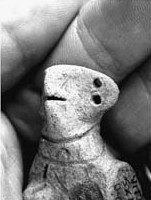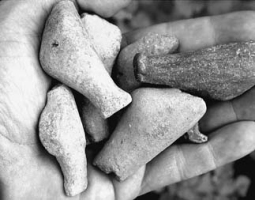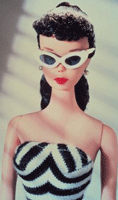Lynn Meskell's experimental videos with the Catalhoyuk figurines.
Powerpoint Presentation
Questions, ideas, notes for discussion
- In his introduction to Prehistoric figurines, Bailey gives an interesting overview of the material worlds of the Neolithic societies, the Neolithic way of life, their world-views, mentalities. As these early agricultural societies who lived in settlements, cultivated plants, domesticated animals, were the first to produce anthropomorphic and zoomorphic figurines in great quantities, to discuss the cultural context of such material practice is crucial. In our discussion, let's address some of the significant transformations of the Neolithic societies as pointed out by Bailey and others. Why do you think settled life coincides with a dramatic increase in the making of objects?
- Why are figurines, among other artifacts, so seductive to archaeologists? Could we see this strange attractive power of the figurines that Bailey discusses as an extension of their significance in the Neolithic context, which seeps into or academic mentalities and museum strategies? If the figurines were anectodally identified as mother goddesses, "dolls, toys, magical items, afterlife accessories, sexual aids, fertility figures, effigies, talismans, ritual figures, concubines, slaves, puberty models, training mechanisms, votive and healing objects, items used in initiation ceremonies, contracts, territorry and identity markers..." (Bailey 12), what is wrong with such functional identifications?
- One of the major problems in figurine studies in archaeology is the representation of gender and sexuality in human-shaped figurines. This is largely because modern concepts of gender and sexuality are frequently and uncritically imposed upon prehistoric figurines. Archaeologists often obsessively try to identify the figurines simply as male or female, assuming the clear-cut and excessively polarized concepts of gender in the modern Western world to be cross-cultural and transhistorical. Instead, how is gender defined in Bailey and Meskell, and according to them, how does more recent critical work on figurines deal with this problem?
- Certain interpretations of prehistoric figurines seem to emphasize performative role of the figurines in ceremonies and everyday life, particularly in maintaining, reconstituting social relationships, interactions among individuals, social groups, their ancestors etc. In these contexts, instead of simply representing individuals or supernatural beings, the figurines appear as social actors, agentic efficacious devices. This nicely relates us to the whole discussion of dolls, particularly Barbie Dolls, and their contemporary status among children. Let's discuss the implications of such approach.
- Hi all, take a look at this website: it is about Cindy Jackson, the woman who wants to be barbie ( chapter 4, bailey book) http://en.wikipedia.org/wiki/Cindy_Jackson . See you tomorrow, Claire



Image Sources: Bailey 2005 + web.
Excerpts from Mondo Barbie, edited by Lucinda Ebersole & Pichard Peabody (New York : St. Martin's Press, 1993).
Barbie Jose Padua

Barbie Dolls Leslie Shiel

Barbie Gary Soto


 Prehistoric Figurines
Prehistoric Figurines